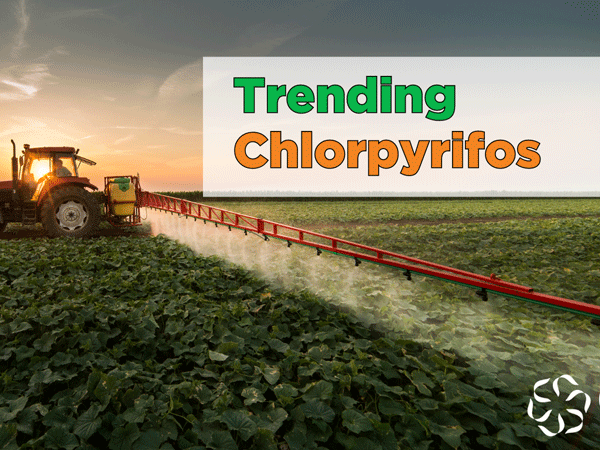Recently, U.S. federal regulators banned the pesticide chlorpyrifos for agricultural use. In this post, we take a look at this chemical and explain what this means.
What is chlorpyrifos? Why was it used?
In common terms, chlorpyrifos is a pesticide used primarily in agricultural settings to kill pests, like insects, that can impact crop growth (1).
Manufacturers also used chlorpyrifos in cattle ear tags. They infused cattle ear tags with a small amount of chlorpyrifos, which slowly distributed the ingredient over the animal to help control pests (1,2).
Farmers used the ingredient from 1965 until August 2021 (1,2).
How does chlorpyrifos work?
Farms applied manufacturer-recommended and legally allowed amounts of chlorpyrifos to crops such as corn, soybeans, cotton, and fruit and nut trees.
When pests come into contact with the ingredient on the crop, chlorpyrifos blocks the enzyme acetylcholinesterase. The enzyme is required for controlling messages between nerve cells. Without the enzyme the pest’s nervous system malfunctions, leading to the pest’s death (1,2).
Why was chlorpyrifos banned?
There were diverging conclusions on chlorpyrifos’s safety based on a few different studies that examined the ingredient’s health effects (1).
Some studies showed chlorpyrifos did not negatively impact human health. Still, some regulators felt those studies did not contain large enough sample sizes and were not representative of the population (1,2).
Newer evidence from epidemiological and animal studies suggested that aggregate exposure to the ingredient might negatively impact children’s development. That outcome is a more sensitive health effect, meaning researchers would need to recalculate a new safe exposure level that accounts for this sensitivity (1,2,3,4).
One of the most influential studies in the EPA’s final decision was an epidemiological study of infants and children conducted by the Columbia University Children’s Center for Environmental Health, which reported a positive association for attention disorders, attention deficit hyperactivity disorder (ADHD), and pervasive development disorder when comparing high to low chlorpyrifos exposure groups (1).
Yet the EPA also identified numerous uncertainties within the Columbia study among others a modest sample size, limited information on chlorpyrifos exposure, the potential for misclassification of individual exposure measures, and lack of availability of the actual (raw) data from the study. In addition, pregnant women and children in this study were exposed to multiple chemicals which work in a manner similar to chlorpyrifos (1).
Despite the limitations in the epidemiological studies, the U.S. Court of Appeals for the Ninth Circuit ruled that the EPA was required to demonstrate that the ingredient did not cause harm by August 20, 2021.
The EPA’s risk assessment process uses all currently available science to determine a safe exposure level. When vulnerable populations are exposed to ingredients it needs to be at known safe levels (1,2)
Using the currently available science in their risk assessment process the EPA could not conclude with reasonable certainty that chlorpyrifos would cause no harm at those levels allowed for agricultural products when all exposure pathways (e.g., food, water, residential) were taken into consideration, in aggregate and in particular, when considering drinking water. As a result, the EPA revoked its approval for chlorpyrifos (1).
Does this mean all pesticides are harmful?
No. As we’ve discussed in a prior post, the EPA and other regulatory agencies use risk assessments that consider the currently available research that shows the potential health impacts of pesticide ingredients (1,2,3,4).
Other approved pesticides currently used are not known to cause adverse health impacts at legally allowed levels (1).
Additionally, since 2007, the EPA began a systematic review of approved pesticides to ensure they are safe for all people, including vulnerable populations like children (1).
Will the EPA ban other pesticides?
Science and research are evolving processes in all fields, including toxicology. The more scientists investigate ingredients’ health impacts, the better we can determine their safety.
If the science concludes that a pesticide causes harm or cannot conclude with reasonable certainty that no harm will be caused at levels that people would be exposed to, then yes, it will be banned. However, it doesn’t mean all pesticides used at currently allowed levels cause harm.
The good news.
We can see how the regulatory agencies consider all available data points and use the available information to make decisions regarding the safe use of specific ingredients. We know that continued research can provide regulators with more information, allowing them to make decisions based on robust evidence.
This is good news for consumers who trust in our agencies to help keep our food supplies safe

